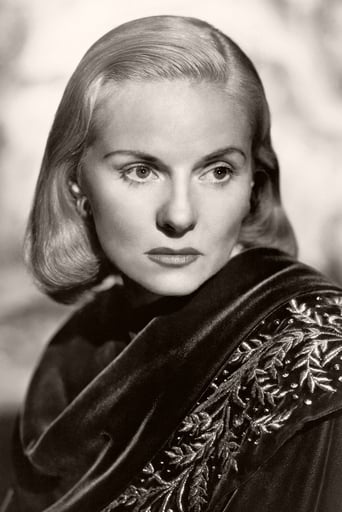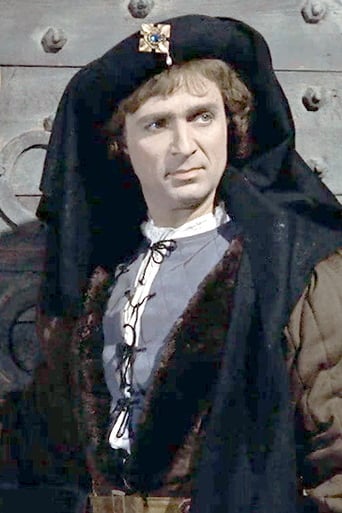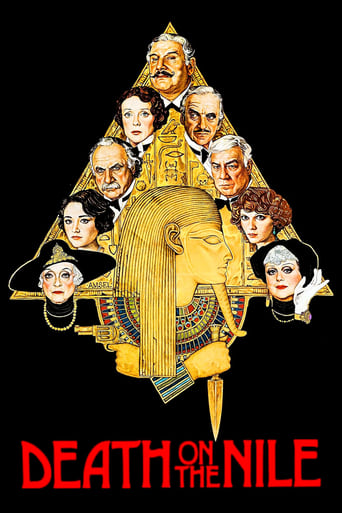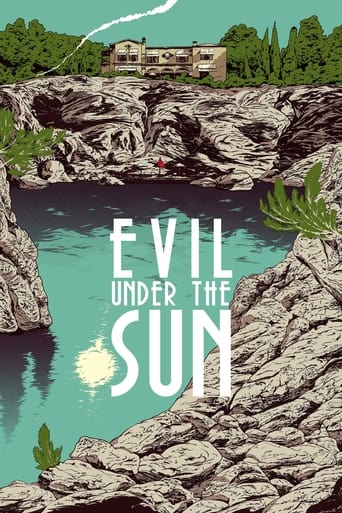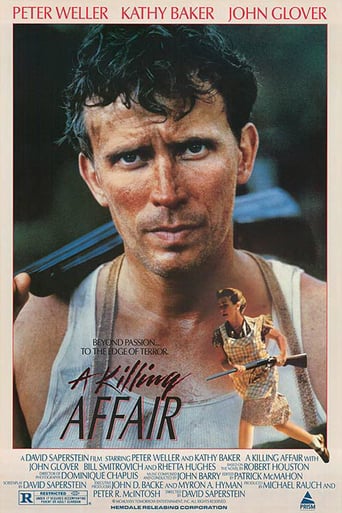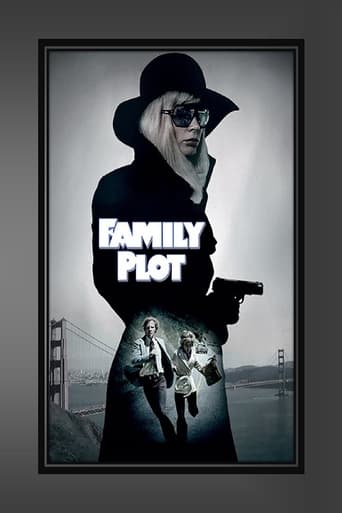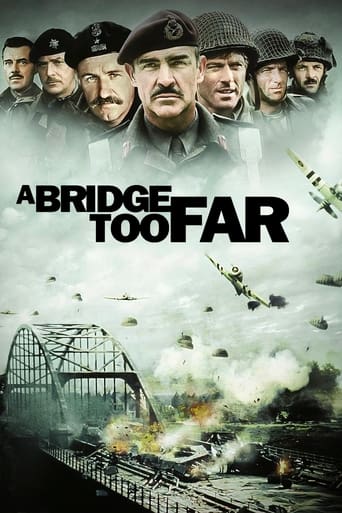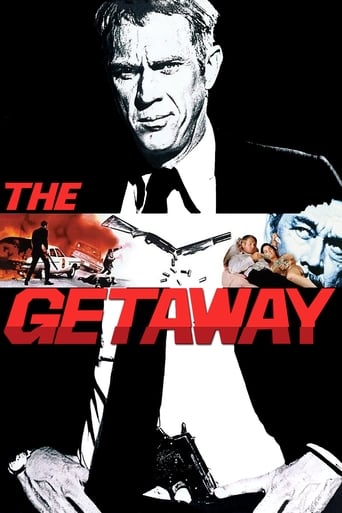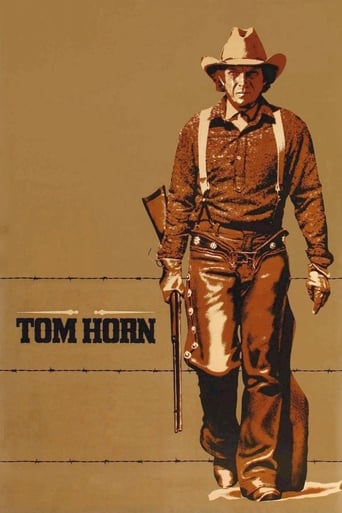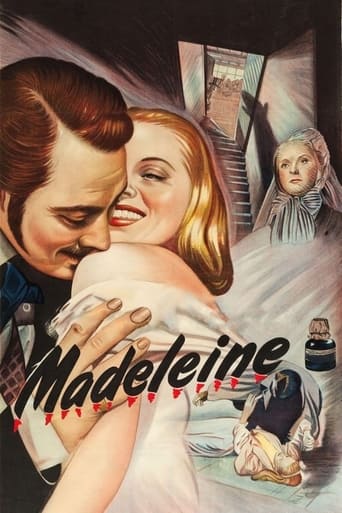
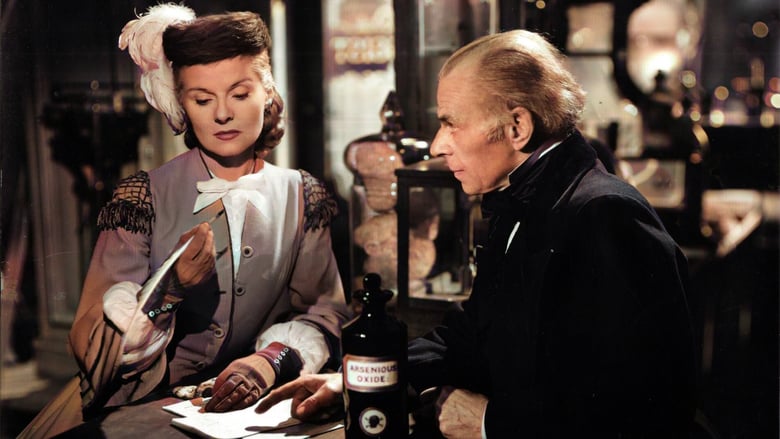
Madeleine (1950)
The middle-class family of a young woman cannot understand why she delays in marrying a respectable young man. They know nothing about her long-standing affair with a Frenchman.
Watch Trailer
Cast


Similar titles
Reviews
As you will know from reading other reviews this film is based on a true crime from Scotland in the 1850's.The question is: what does David Lean make of this material? At first he seems to be making a study of the repression of women in Victorian society. Madeleine Smith's life at home is dominated by a stern father who expects his daughters to do their duty by him, even changing his shoes! The bars on Madeleine's bedroom windows are a not too subtle symbol of her caged existence. A breath of freedom and excitement seems to come in the form of a lover, but even he just wants to use Madeleine to advance his social position and can be brutal when his ambition is frustrated - he is certainly not a romantic hero. It is interesting that on the two occasions when we can clearly infer he and Madeleine make love (the first time against the background of a Scots ceilidh, which makes for some very erotic imagery), it is done from a position of dominance on his part, he is literally standing over her.The man Madeleine is expected to marry seems honourable and decent, but he too will prove incapable of loving her as a real person - she must be flawless. When the lover turns to blackmail it seems Madeleine has no way out but to turn to poison.Now the film becomes a courtroom drama. Do we want to see Madeleine acquitted or not? Did she poison Langelier? The end of the film answers this question with an enigmatic smile into the camera from Ann Todd (the 'fourth wall' is broken several times in the film).What we are left with, then, is a film which appears to start from a feminist viewpoint, then becomes a romance, then a crime procedural. From being deeply involved in Madeleine's story, we become distant from her when she is charged with murder. Ultimately we don't really care about her fate, and an unsolved crime is always strangely unsatisfying.There are some great moments of cinematography (particularly deep-focus photography) and image-making here, but the film is not quite a satisfying whole, with too many loose ends (her family's reaction, for example; I'm sure 'Papa' was outraged but he still provided the best lawyer he could find) to make a rounded drama.
No need to recap the plot.My favorite scene and arguably the most significant is where Madeleine breaks free into her spontaneous little dance. Note how she's suddenly responding to the foot-stomping liveliness of the community dance, quite a contrast to the confining rhythms of the upper- class ballroom she's used to. This is the "real" Madeleine surfacing outside her upper-class confinement. And once loosened, it's not surprising that seduction follows.The trouble is that from now on she's "damaged goods" according to patriarchal mores of her time. Frankly, the scene reminds me of the raucous music and love-ins of the counter- cultural 1960's, which produced similar effects on straitened middle-class youth. Given her later affiliations (thanks to reviewer Theowinthrop), perhaps the historical Madeleine is an early hippie type reacting to ten confining pounds of petticoated skirt.Except she's no one to mess with. Fortune-hunter Emile has trifled with her affections, compromised her marriageability, and now wants to blackmail her. It's hard for me to believe she didn't rid herself of the bounder, no matter how cleverly director Lean plays with the visual evidence. Besides, who commits suicide with an excruciating substance like arsenic, especially a canny character like Emile. Maybe there wasn't enough evidence for conviction, but the finger of guilt appears overwhelming.The movie itself amounts to a stylistic triumph. Those Gothic early scenes are beautifully staged, as other reviewers spell out. Just as importantly, the expressionism complements the shadowy nature of the illicit romance and likely mirrors Madeleine's joyless inner life. I also like the way actress Todd turns on the spark at the community dance in contrast to her usual cold demeanor. My one reservation is with the abrupt transition from Gothic drama to courtroom procedure. Lean does his best to establish stylistic continuity, but the contrast in tone and direction remains. Then too, I suspect the unresolved ending was not popular with many audiences of the day; at the same time, it's hard to see a Hollywood studio taking the same risk. Nonetheless, the film remains highly compelling despite the non-Parry Mason ending.
Ann Todd is "Madeleine" in this 1950 film directed by David Lean. The film also features Norman Wooland, Ivan Desny, Andre Morrell and Elizabeth Sellars. The film looks at the true story of the famous Madeleine Smith murder trial in the mid-1800s. Pressured by her upper class family to marry, Madeleine is in fact secretly intimately involved with a man from a lower class, L'Anglier (Desny) and has agreed to marry him. She doesn't want to tell her family, so she urges him to elope with her. L'Anglier was planning on marrying into the upper class lifestyle and insists instead that she tell her father (Leslie Banks) about their relationship. She can't, and believing that all L'Anglier wanted was her money all along, she breaks off with him and requests the return of her letters to him. She then agrees to marry William Minnoch (Wooland), who has been courting her.L'Anglier doesn't return her letters, and after she purchases arsenic, he dies of arsenic poison, having become ill at her house once before. Madeleine is arrested for murder.The film seems to follow the case quite accurately, but it's pretty cut and dried. There are some marvelous scenes - the two dancing in the moonlight is one, as an increasingly wilder dance goes on inside. The structure of the courtroom was interesting, as I had never seen a prisoner walk upstairs into the dock from what is almost a trap door in the floor. The view of all the faces looking down before she starts the climb gives an idea of what it's like to be put on trial.Ann Todd is a good actress, though an internalized one who comes off as rather cold. She was married to Lean, which may be the reason for her casting. At the time of the murder, Madeleine's father was displeased that she wasn't married, complaining that she had met many men but none of them have worked out. She was twenty when she took up with L'Anglier and 22 when she broke it off. Todd was 41 at the time this film was made. She was not carefully photographed and looked her age - way too old for this role. Andre Morrell is excellent as Madeleine's attorney. The rest of the performances are very good, with Banks a strong, intimidating father and Desny hinting at the slime that's below the surface of L'Anglier. Norman Wooland gives a charming and concerned performance as Madeleine's suitor, Minnoch.Lean's opinion of what happened is made very clear in the last moments of the film. Someone said the story needed Hitchcock's hand, but he was not successful with "The Paradine Case." There's something about these stories that is very detached and unemotional. Maybe Hitchcock could have cracked it; this early effort by David Lean doesn't quite make it.
David Lean's film Madeleine tells the true story of Madeleine Smith, a young woman from an upper-class Scottish family, who was tried for murdering her lover in 1857. The case, which was a media sensation in its day, ended with Ms. Smith being released after the jury reached the verdict of "not proved", which, in Scottish law, meant there wasn't enough evidence to convict her but sufficient evidence to entertain doubts about her innocence. The movie maintains the same ambiguity about her guilt or innocence of the crime, indeed ending with a voice over narrator asking the title character as to whether she was guilty or innocent. She just looks at the camera and gives a vague half smile that could mean either of the two.The strengths of the film are considerable. The lighting and overall cinematography give the film both a wonderful Victorian-era feel and a film-noir aspect as well. Indeed, the film has much in common with film-noir aside from the lighting. The story, like many noir films, has a dubious heroine who leads a fundamentally disadvantaged man, in this case, a lover from the wrong side of the tracks economically and socially, to his destruction. Indeed, given the situation presented in the film, the lover couldn't have realistically expected Madeleine's domineering and strict father to have ever accepted him given his poor social and economic prospects. Adding into the mix was Madeleine's own ambivalent handling of their relationship, promising one moment to tell her father about them, then pleading it was too difficult to do so. As history indeed bore out, it was a recipe for personal disaster.My main criticism of the film is that virtually nothing is told of how Madeleine managed to meet her lover in the first place. Some accounts I've read indicated that they first met in a Glasgow park. I think Lean should have shown that meeting to show how Madeleine had a mind of her own and how willing she was to defy her conventional and strict Victorian father. That would have added to the ambiguity of Madeleine's character, seemingly compliant to the demands of her family in terms of love and marriage and yet defiant of them as well.Still, the performances, especially Ann Todd as the title character, are top notch and this is a film well worth seeing. As I've said, this is the closest David Lean came to film-noir that I've seen.


